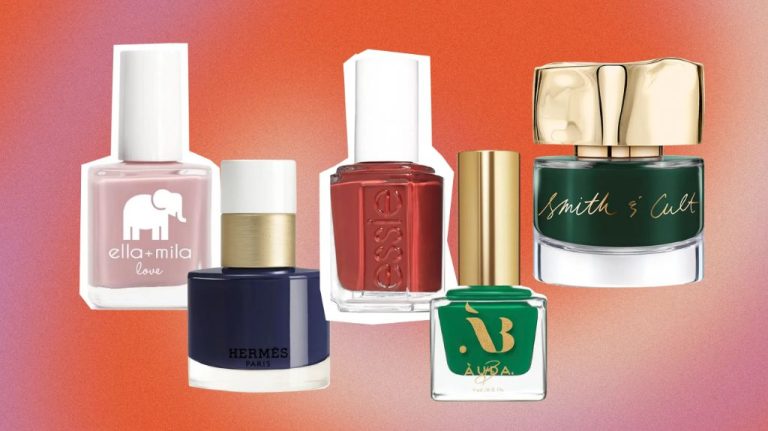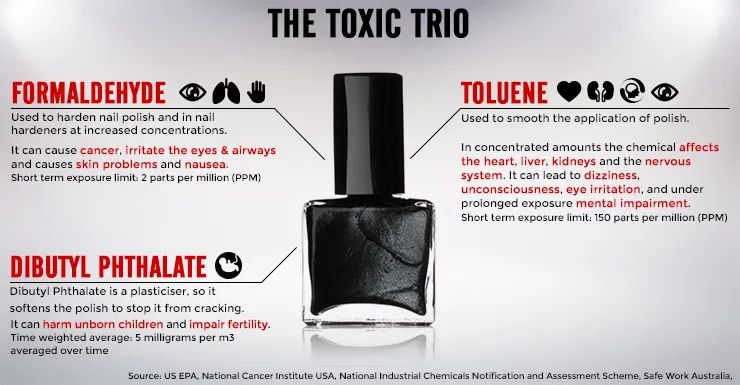Eco-Conscious Nail Care: Sustainable Solutions For Beautiful Nails
The Environmental Impact of Traditional Nail Products
Traditional nail products like acrylics, gel polish, and regular nail polish contain concerning chemical ingredients that can negatively impact the environment.
Many polishes and acrylic powders contain formaldehyde, toluene, dibutyl phthalate (DBP), and triphenyl phosphate (TPHP) – chemicals that are known irritants and have been linked to cancer, birth defects, and other health issues. While exposure is limited with nail products, these ingredients get washed down drains and end up polluting waterways (1).
Nail polish bottles and remover containers create unnecessary plastic waste. The average person will use over 400 bottles of nail polish in their lifetime (2). Most polishes come in glass bottles with plastic caps and brushes that cannot be properly recycled.
Nail salons generate large volumes of chemical waste from acrylics, gels, polishes, and removers. Much of this waste gets washed down drains. Many salons lack proper hazardous waste disposal and ventilation, putting workers and clients at risk (3).
Opting for eco-friendly natural nail products is an easy way to reduce the environmental impact of nail care.
(1) https://www.refinery29.com/en-us/are-acrylics-gel-press-on-nails-bad-for-environment
(2) https://perrierplanning.com/2021/08/01/tips-for-rocking-eco-conscious-nails/
(3) https://www.buro247.my/beauty/buro-loves/are-manicures-eco-friendly-for-the-planet.html
Choosing Natural Ingredients
When choosing nail polish and other nail products, it’s important to look for natural ingredients that are safer for your health and the environment than synthetic ingredients. Natural ingredients use plant-based sources as opposed to chemicals created in a lab. Major synthetic ingredients to avoid include formaldehyde, toluene, dibutyl phthalate (DBP), and camphor. These ingredients have been linked to birth defects, organ system toxicity, and cancer risk.
Natural nail care products will use ingredients like plant oils, waxes, antioxidants, and vitamins. These provide rich pigment and shine while nourishing nails and cuticles. Common natural nail polish ingredients are linseed oil, beeswax, vitamin E, castor oil, rosemary extract, and bamboo extract. Not only are these less harsh, but many provide moisturizing benefits to strengthen weak, brittle nails.
When shopping for natural nail polish and care items, look for “toxic-free” labels like 10-free, 12-free, 15-free or higher. These signal that 10+ major toxic ingredients have been eliminated. Other natural certifications to look for are USDA Organic, EWG Verified, Leaping Bunny cruelty-free, and vegan. Reading reviews for non-toxic brands can further help identify truly natural products made with safe, plant-based ingredients versus harsh chemicals disguised as “natural”.
Sources:
https://www.goodhousekeeping.com/beauty/nails/g28834890/best-natural-non-toxic-nail-polishes/
https://healthstartsinthekitchen.com/the-best-non-toxic-nail-polish/
Eco-Friendly Nail Polish Brands
There are several eco-conscious nail polish brands available today that use natural, non-toxic ingredients and sustainable practices. Some top options include:
Sienna – This vegan and cruelty-free brand offers nail polishes made without harsh chemicals like formaldehyde, toluene, DBP, and camphor. Their polishes use plant-based ingredients like bamboo extract and are formulated in the USA.
Ella + Mila – Their polishes are vegan, gluten-free, and made without any nasties. The brand focuses on using natural ingredients like vitamin E and argan oil. They also aim to offset their carbon footprint by planting trees.
Pacifica – This brand offers vegan and cruelty-free polishes made with plant-based ingredients like flax seed, sunflower, and jasmine extracts. Their formulas are 7-free and come in eco-friendly packaging.
These eco-conscious nail polish brands allow you to color your nails gorgeously while making more sustainable choices. Going with natural, non-toxic polish is a simple way to reduce your environmental impact.
Non-Toxic Nail Salons
More and more nail salons are shifting to using non-toxic products and implementing eco-friendly practices. These salons avoid using harmful chemicals like formaldehyde, toluene, and dibutyl phthalate in their nail polishes, gels, acrylics, and removers. Instead, they opt for natural, plant-based ingredients that are safer for your health and the environment.
Non-toxic nail salons offer manicures and pedicures using polishes made with ingredients like water, corn, potatoes, and bamboo rather than harsh solvents. Brands like Paint Nail Bar and Dear Sundays are popular choices. The polishes are free of the “toxic trio” and other chemicals linked to cancer, organ toxicity, and respiratory issues. Services moisturize nails naturally with oils and butters instead of acrylics or UV lamps which can damage nails.
Opting for a non-toxic manicure avoids exposure to fumes from volatile chemicals. This improves air quality for salon works and patrons. The health benefits for customers include avoiding headaches, rashes, and other reactions associated with chemical ingredients. Overall, non-toxic nail salons offer a safer, cleaner, and more eco-conscious way to enjoy beautiful nails.
DIY Natural Nail Polish
Making your own natural nail polish at home is a great way to avoid the harsh chemicals found in many mainstream polishes. Natural DIY nail polish recipes often use simple, nourishing ingredients like olive oil, beeswax, and essential oils.
A basic DIY nail polish recipe includes:
– 4 tablespoons olive oil
– 1 teaspoon beeswax
– Vitamin E oil
– Essential oils for scent (optional)
The olive oil helps condition nails and cuticles while providing a glossy finish. Beeswax gives the polish thickness and helps it adhere to the nails. Vitamin E oil strengthens nails and prevents chipping and cracking. Essential oils like lavender or lemon add a light, natural fragrance.
To make the polish, melt the beeswax in a double boiler or small pan on low heat. Once melted, remove from heat and whisk in the olive oil and vitamin E oil. Let cool slightly and add several drops of essential oils if using. Pour into small jars or reusable nail polish bottles.
Tips for best results:
– Make small batches that can be used up within a month or two for freshness.
– Experiment with natural colorants like beet powder, turmeric, cinnamon, or alkanet root.
– Store homemade polish in a cool, dark place to preserve ingredients.
– Apply 2-3 thin coats and finish with a natural topcoat for lasting wear.
With nourishing oils, beeswax, and plant extracts, natural DIY nail polish is a safe, non-toxic alternative to standard polish (Source: https://draxe.com/beauty/diy-nail-polish/). Kids will love getting creative and painting their nails with homemade polish made from simple, safe ingredients.
Caring for Nails Naturally
There are many natural ways to care for nails that avoid harsh chemicals found in conventional nail products. Using natural oils and remedies is an eco-friendly approach that can lead to healthier nails.
Olive oil and coconut oil are great options for moisturizing brittle nails and cuticles. Apply a few drops directly to the nails and massage in. The fatty acids help strengthen nails and condition dry cuticles [1]. Jojoba oil, vitamin E oil, and almond oil also penetrate the nails to provide hydration.
For discolored or stained nails, lemon juice can help brighten. Soak nails in fresh lemon juice for 10 minutes. The citric acid gently removes staining [2].
Baking soda mixed with water makes an effective but gentle nail scrub. Gently scrub nails to remove debris and improve circulation. Finish by rinsing and applying a natural moisturizer.
No matter what products are used, be sure to thoroughly dry nails after washing hands. Trapped moisture under nails can encourage bacterial and fungal growth [3].
Eco-Friendly Nail Tools
Traditional nail tools like emery boards, metal cuticle pushers, and plastic nail brushes often end up in landfills and can contain harsh chemicals. Eco-friendly options provide a more sustainable alternative.
Bamboo nail files are a popular reusable option. The natural fibers gently file nails without tearing. Glass nail files are also smooth on nails and fully recyclable. Both bamboo and glass files last longer than traditional emery boards.[1]
Reusable nail buffers made of wood, bamboo, or crystal can replace standard foam buffers. These sustainable options provide similar shine and smoothing without the waste.
Wooden cuticle pushers and nail brushes avoid plastic waste. Seek out FSC-certified wood from sustainable forests. Look for natural bristles like tampico fiber on nail brushes.
Buying eco-friendly nail tools supports sustainability while still providing salon results at home. Brands like Tropical Shine[2] and Naturluxe[3] offer recyclable nail files and refillable glass files to reduce waste.
[1] https://www.thegoodtrade.com/features/diy-at-home-manicure/
[2] https://www.amazon.com/Tropical-Shine-Eco-Files-Recyclable-Coarse/dp/B07X1F2ZQ6
[3] https://ecobeige.com/products/natural-nail-brush
Sustainable Nail Art
Sustainable nail art uses natural materials and avoids plastics and glitter to reduce environmental impact. Some eco-friendly techniques include:
Using plant-based polishes and top coats made without harsh chemicals (cite: https://www.etsy.com/market/sustainable_nail_art).
Trying nail vinyls made from wood pulp or other biodegradable materials instead of traditional plastic decals (cite: https://sistaco.us/collections/sustainable-nail).
Using natural materials like dried flowers, leaves, seeds, etc. to create designs.
Avoiding glitter, plastic confetti, and other non-biodegradable embellishments.
Seeking reusable nail art tools like silicone stampers instead of disposable plastic ones.
Opting for subtle, minimalist designs over complex multi-step looks requiring many disposable tools.
Focusing on nail art longevity by using gentle removal techniques to avoid redoing designs frequently.
Sustainable nail art allows creativity and self-expression while reducing waste and chemical exposure.
Improving Salon Sustainability
One of the best ways to make nail care more sustainable is by improving the practices at nail salons themselves. Start by choosing a green certified salon wherever possible. Salons like Tina Green Nail in Brooklyn have taken steps to use nontoxic polish, natural materials, and eco-friendly practices. When choosing a new salon, don’t be afraid to ask questions about the products and practices they use – most environmentally-conscious businesses will be happy to share their efforts.
Ask if the salon uses toxic-free polishes and treatments. Many traditional polishes and products contain ingredients like formaldehyde, toluene, and dibutyl phthalate (DBP) which are harmful to human health and the environment. Seek out salons that use polishes with natural, plant-based formulas instead. You can also inquire about their nail file sanitization, ventilation, waste management, and recycling programs. Many salons now aim to go zero waste and use reusable tools and products as much as possible. Discuss any allergies or sensitivities you have too, as salon staff can recommend gentler products if needed.
It’s empowering as a consumer to vote with your dollars and choose greener businesses. Let your nail salon know that sustainability is important to you – this lets them know there is demand for eco-conscious practices. With client encouragement, more salons can implement changes to make nail care cleaner and greener for everyone.
Beautiful, Healthy Nails
The takeaway message of adopting eco-conscious nail care habits is achieving beautiful, healthy nails. By avoiding toxic ingredients, reducing waste, and utilizing natural products, you can have good-looking nails that also minimize damage to the environment. Some key strategies include:
- Choosing natural nail polishes made from ingredients like water, essential oils, and plant resins. Brands like Karma Organic Nail polish use safe, non-toxic formulas.
- Visiting green nail salons that use vegan polishes and practice sustainability. Look for salons that ventilate properly and avoid toxic chemicals.
- Trying DIY recipes to make your own natural nail polish at home. You can find recipes using ingredients like olive oil and beeswax.
- Massaging cuticles with oils to stimulate growth. Jojoba or coconut oil help condition nails and cuticles.
- Buffing nails to shape and shine instead of using acrylics or gel polish that can damage nails.
- Switching to sustainable nail tools made of glass, bamboo, or reusable metals.
Following eco-conscious nail care habits allows you to have healthy, beautiful nails while also reducing your environmental footprint. The end result is nails you can feel good about.



